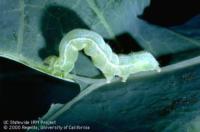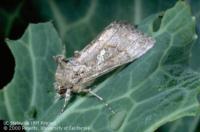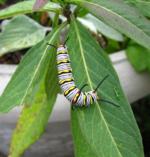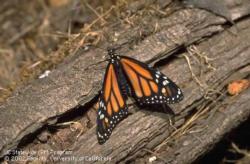Caterpillars do damage in the vegetable garden and on ornamental plants as well. There are many different kinds of caterpillars, and sometimes it's hard to tell them apart.
Photographs of 6 common caterpillars Many caterpillars are the larval form of moths.
Eggs are laid singly or in clusters on undersides of leaves or other out-of-the way places near a food source. The larvae hatch and begin to feed on the nearby food.
Control Most caterpillars are susceptible to
Bacillus thuringiensis (Bt) or
spinosad, both bacterial-based pesticides. Bt should be applied to surfaces where the caterpillars feed, since it must be ingested to be effective. Spinosad kills both on contact with the caterpillar and when the caterpillar ingests it, but is also much more effective if insects ingest it. Both agents work best on small caterpillars.
Caterpillars are also controlled by
general predators such as green lacewings, spiders, among others, and insect
parasites. Parasites are tiny wasps (about 1 mm) that lay their eggs inside small caterpillars; the caterpillars are killed as the eggs hatch.
Another method of control is to use a physical barrier to keep moths from laying eggs on your plants.
Floating row covers protect young seedlings, and can be removed as the plants mature.
Remember that caterpillars can also be the larval form of butterflies, so consider tolerating some caterpillar activity in your garden. Identifying the caterpillar can be helpful before employing pest control methods.

 Control
Control Remember that caterpillars can also be the larval form of butterflies, so consider tolerating some caterpillar activity in your garden. Identifying the caterpillar can be helpful before employing pest control methods.
Remember that caterpillars can also be the larval form of butterflies, so consider tolerating some caterpillar activity in your garden. Identifying the caterpillar can be helpful before employing pest control methods.




